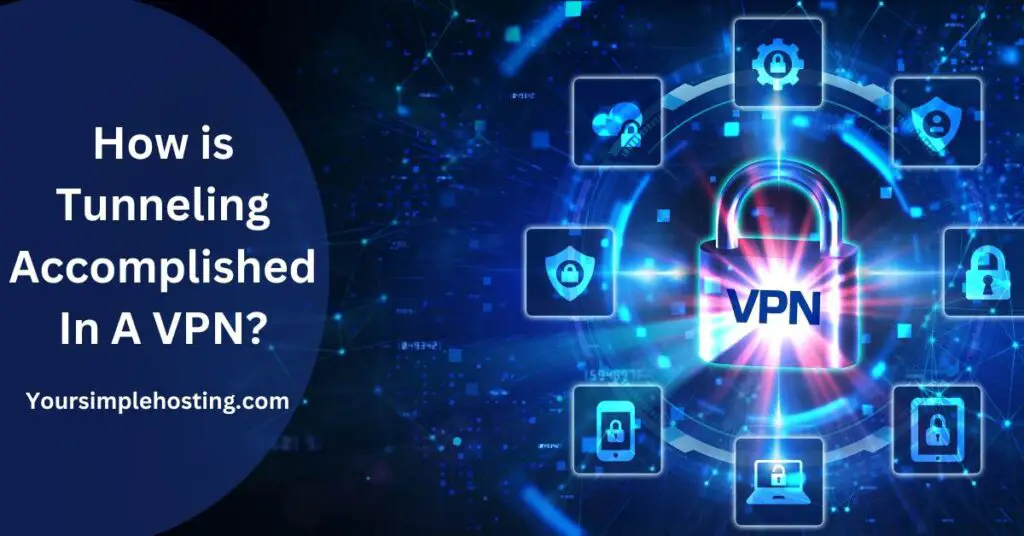Tunneling is a process by which information is securely transported across public and private networks. It is commonly used in virtual private network (VPN) solutions as it allows users to securely access remote resources without being exposed to the spies and dangers lurking on the Internet.
VPNs use tunneling to ensure that data moving across the Internet remains secure and private by encrypting it.
This article will explain how VPN tunnels work, and the protocols used to establish secure VPN connections.

How is Tunneling Accomplished in a VPN?
You will first sign up and join the virtual private network service to connect to a VPN tunnel. Once this is done, your system will start masking your IP address from your Internet Service Provider (ISP) for all your online searches, downloads, and more.
In VPN Tunneling, your provider builds a barrier surrounding your online activity so that it remains hidden from everyone. Furthermore, your VPN provider encrypts the data so that no snoops can decipher it or track you.
In essence, no one can track your downloads, search history, videos, etc., and your browsing sessions will be anonymous while the VPN tunnel is established.
Tunneling and Its Applications
Tunneling is essentially the process of encapsulating data from between your computer to the VPN server.
This is useful for applications such as remote access, which requires confidential and secure transmissions across the Internet. It can also bypass firewalls or systems that use the user’s IP address to determine their location, allowing users to access websites or other resources that are otherwise blocked.
Advantages of Using a VPN for Tunneling
Using a VPN for tunneling has several advantages over traditional methods. Firstly, it provides an additional layer of security by encrypting data before it is transmitted across the Internet. This makes it much more difficult for hackers and malicious actors to intercept and gain access to sensitive information.
Furthermore, VPNs can also help bypass geographical restrictions and censorship as the data is encrypted and routed through a different country. This allows users to access websites or other resources that may not be available in their own country.
How Tunneling Works in a VPN: In-depth Explanation
Tunneling is accomplished by sending data through an encrypted tunnel between two computers. This allows users to securely access remote resources without being exposed to trackers. We’ll now look at the steps involved in establishing a secure tunneling connection and sending data through it.
Step 1: Establishing the Connection
The first step is to establish a secure tunnel between two computers. This requires authenticating each computer, verifying that both have permission to access the resources they request, and negotiating encryption parameters. Once the connection is established, data can be sent between the two computers.
Step 2: Encryption and Authentication of Data Packets
Once the connection has been established, each data packet will be encrypted with a unique key and authenticated before sending it across the tunnel. This ensures that the data is secure and can only be read by the intended recipient. Additionally, if one of the packets is corrupted during transmission, it will be discarded, and a new packet will be sent in its place.
Step 3: Handoff to the Destination Network
Once the data has been encrypted and authenticated, it is then sent to the destination network, where it can be accessed. The data will then be decrypted and authenticated at the destination network before being delivered to its intended recipient.
Different Protocols Involved in Establishing VPN Connections
Several different protocols can be used when establishing a secure VPN tunnel connection.
Each protocol has advantages and disadvantages depending on the type of connection being established and the user’s security requirements.
Point-to-Point Tunneling Protocol (PPTP)
PPTP is an older protocol developed by Microsoft in the 1990s and is still widely used today. It is a simple protocol that provides basic encryption, authentication, and access control for secure connections. Unfortunately, PPTP offers poor security, which makes it ok for applications such as remote access, for example, remote desktop, but unsuitable for highly sensitive data.
Therefore, I would not recommend using a VPN that relies on the outdated PPTP, which has multiple security vulnerabilities.
Layer 2 tunneling Protocol (L2TP/IPsec)
L2TP is a protocol developed by Cisco and Microsoft in the late 1990s that provides additional security compared to PPTP; L2TP is an extension of PPTP. It combines the encryption and authentication features of both L2TP and IPSec to provide a more secure connection. In addition, it supports other features, such as multiple tunneling protocols and dynamic IP assignments.
Even though L2TP\Ipsecis still in use today, it is a legacy VPN protocol. I suggest using a VPN that uses OpenVPN or IKEv2 protocols.
Internet Protocol Security (IPsec)
IPsec is a protocol developed by the Internet Engineering Task Force (IETF), and it is currently one of the most commonly used protocols for VPN connections. It provides strong encryption, authentication, and access control for VPN connections, making it well-suited for applications that require a high level of security.
Secure Socket Tunneling (SSTP)
Microsoft developed SSTP to replace PPTP and LPTP/IPsec, which makes STTP more secure than either of these protocols.
Since SSTP uses SSL and port 443, which is the same as when you access a website using HTTPS, this makes it harder for firewalls or ISPs to block the VPN connection. Using port 443 also increases the chances of the VPN connection, as 443 is not a standard port to be blocked.
SSTP is not an open source, as Microsoft owns it, so it is difficult to check if there are any backdoors.
Internet Key Exchange Version IKEv2
IKE is a protocol developed by the Internet Engineering Task Force (IETF) in the late 1990s. IKEv2 has strong security and provides fast transfer speeds. Microsoft Always on VPN uses IKEv2. In addition, IKEv2 offers excellent support for switching between networks by maintaining a VPN connection.
However, you may find that some Firewalls will block the UDP ports IKEv2 uses, which are UDP 500 and 4500, which will prevent the VPN from connecting.
OpenVPN Protocol
The OpenVPN protocol was created in 2001 and is the most used and secure VPN protocol still in use today. OpenVPN uses SSL/TLS to encrypt the VPN traffic, and the encryption level is 256-bit, making it very difficult to crack.
OpenVPN can be configured with even stronger encryption
- AES (Advanced Encryption Standards)
- 3DES (Triple Data Encryption Standard)
- Blowfish
- CAST-128
OpenVPN uses port 443, which results in a more reliable VPN connection. Using port 443 also increases the chances of the VPN connection, as 443 is not a standard port to be blocked.
Conclusion
Tunneling is essential in establishing secure connections over a public or private network, particularly when using a VPN. It provides encryption, authentication, and access control for sensitive data, ensuring that only authorized users can access the data.
In addition, it provides a secure connection for accessing remote resources without putting the user at risk from malicious sources on the open Internet. With different protocols available, it is important to choose one that meets the security requirements of your application while still providing an efficient and reliable experience.
Overall, tunneling is an important aspect of establishing secure connections, and VPNs are the best way to ensure that all data is securely transferred over the public Internet. With protocols such as PPTP, L2TP and IPsec available, it is possible to find a solution that meets your security needs while providing an efficient user experience.

Leave a Reply